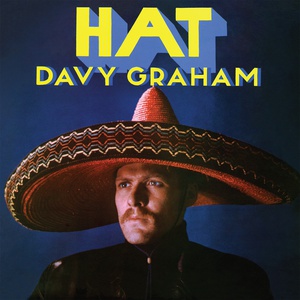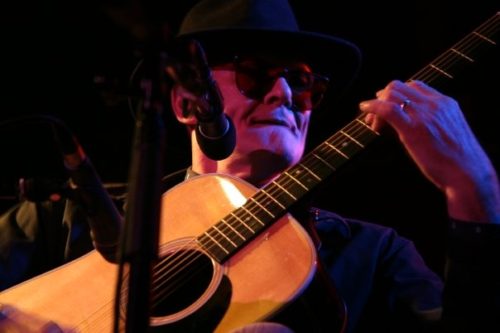 Davy Graham – Hat (Remastered)
Davy Graham – Hat (Remastered)
Bread and Wine – 29 March 2019
I was fortunate enough to see Davy Graham a couple of years before his 2008 death, playing at a month-long festival of folk at Spitalfields in London. It was a session like no other I had witnessed before or since. The guitar playing was still of a masterful standard, the occasional bit of singing less so but that was never his strongest asset. What I remember above all though was the sense that this man was not interested in the art of performance one little bit. People talk about Bob Dylan paying no attention to his audience but compared to the Davy I saw that night (pictured below), Bob is a veritable people-pleasing raconteur. Davy lifted his hat once or twice, he even listened when the odd brave punter shouted out a request, but only because he preferred total silence whilst playing; there was no intention to honour any shout outs. He was so disengaged with the people present that you wondered if he’d even been told he was turning up to play a gig, if in fact there had been some subterfuge in getting him to attend and agreeing to go up on stage and knock out a few tunes was part of a negotiation to be released from this awkward social engagement. After about 45 minutes he wordlessly got up off his stool and left. So too, the audience shuffled out bemusedly around 9.30pm but, from what I recall, no one complained; after all, we had still spent some thrilling private moments with an absolute master. The lack of ceremony emphasising the preciousness of what we had just witnessed. Had he lived; I would definitely have grabbed the chance to see him again.
It seems remarkable now that this was an artist with a major label recording contract on Decca in the 1960s. That’s Decca, the same label that had the Rolling Stones on their roster at the time. To look at and assess Davy Graham’s recording career from this vantage point, its totally evident he was never going to be motivated by forming the kind of coherent career ark and recording catalogue that these big money labels are investing in. This was a man purely driven by musical considerations, cultural discovery and the investigation of mating potential in all he uncovered. That was his journey, the fuel that got him out of bed in the morning. He did not categorise any music; from classical to baroque, jazz to blues, rock to pop, it was all put in the same melting pot. By his own admission, he would have liked to have learned more instruments, but the acoustic guitar was the vessel he drove to perfection and so Davy Graham would be labelled a folk artist.
Listening again to the two sixties Decca albums that Bread And Wine have re-issued (more on the other soon), there is a suggestion that Davy Graham was in his own way trying to deliver work that would be popular and well received. He certainly wasn’t being a difficult artist, the problem (if there was one it would only have been in terms of sales figures, not musical capacity) was that the average, casual listener is more comfortable with categorisation. But Davy was casting his net all over the place; on the ‘Midnight Man’ album he had tried amplified guitar on three tracks; one of these was a cover of Rufus Thomas’s 1963 Stax hit ‘Walking The Dog’; an odd marriage on paper but this all-rounder carries it like a natural soul man. Now three years later on ‘Hat’ he opens with a version of the Beatles ‘Getting Better’, an interpretation that gives the relentlessly positive Paul McCartney a run for his money in uplifting vibes. How many albums buffer between summer-of-love pop, Jimmy Witherspoon’s ‘Lotus Blossom’ and Art Blakey’s study in Jazz rhythms ‘Buhaina Chant’ within the first four tracks and retain any cohesive sense? If you get behind Davy Graham’s vision and open-minded approach to music, it all stacks up naturally but sadly I’m not sure that enough people did; even in an era as progressive as the late sixties.
Through the seventies, Graham would only occasionally release very low-key records on small, independent labels. Then for the next three decades, he mostly completely disappeared, although a couple of under-the-radar releases and intermittent live appearances continued until the end. Drug addiction had taken a toll and charity work became more of a daily focus, primarily for the mental health charity Mind. Perhaps when you make your mark early and as definitively as Davy did with ‘Angi’, you carry it with you all the way and struggle to move past it? Simon & Garfunkel had included it on their commercial breakthrough ‘Sounds Of Silence’ album, probably ensuring the writer had a degree of dependable income for the remainder of the decade. On ‘Hat’ Davy shows his gratitude to Paul Simon by beautifully interpreting two of his songs, ‘Homeward Bound’ and ‘I Am A Rock’; also acknowledging in his original self-penned liner notes that “Paul is a good friend of mine”. And so, from murder ballads to Bulgarian dance tunes collected by A.L. Lloyd, from the self-explanatory ‘Hornpipe For Harpsichord Played Upon Guitar’ to defining ‘Down Along The Cove’ as “the Bob Dylan blues” this 1969 album (Davy Graham’s final solo release for Decca) is a musical collection full of thrills and nourishment. Inevitably, the guitar playing is supreme throughout and knits the whole thing together without a glitch. And a final word should go to another example of classic period packaging; of course, the Davy Graham album ‘Hat’ features front and rear cover artwork of, what else? Davy Graham wearing a very big hat. Perfect!


